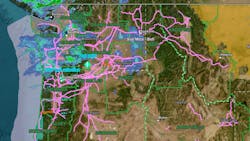BPA Initiates Testing on New Field Reporting Tool Affiliated with Situational Awareness Viewer
Bonneville Power Administration (BPA) has started testing a field reporting tool affiliated with the Situational Awareness Viewer (SA Viewer), a hub for information impacting the transmission system around BPA’s service territory.
Reports provide field crews the ability to record real-world incidents and upload them directly to the cloud-based system.
The Bell District’s Transmission Field Services personnel initiated beta testing the new feature in coordination with BPA's Emergency Management and Geomatics teams. Dominic Caudron, Emergency Management, and Becca Woods, Geomatics, led development of the viewer and formed the Situational Awareness workgroup.
Cary Chaffe, also from Geomatics, has been working alongside Caudron and Woods to develop the field reports and modify them according to the requirements.
“We added quite a few links to BPA and external information sources," Woods said. “We're adding improvements that make the viewer more of a one-stop shop."
The viewer is similar to BPA's Enterprise Geographic Information System (eGIS) Livemaps and both are Esri products, a company developing GIS software. While Livemaps is hosted on BPA's BUD network, the SA Viewer is an online cloud-based system stored on Esri's servers.
The viewer pulls both open-source and BPA data, allowing Emergency Management to provide holistic data and situational awareness of hazards to the rest of the agency.
“These data sources include an all-hazards approach," Caudron said. “The SA Viewer is pulling data from the U.S. Geological Survey, National Interagency Fire Center, Centers for Disease Control and Prevention, Department of Transportation and much more."
Common operating pictures, or COPS, are tools providing a consistent view of an incident to all stakeholders and help manage the data available on the SA Viewer. The SA Viewer's general COP is utilized frequently as it monitors daily activities and small incidents.
Moreover, the SA Viewer includes incident COPs for fire, geologic and pandemic-related incidents that are valuable resources for incident management teams. Field reports uploaded to the viewer are visible in the general and incident COPs. Caudron said the Viewer also has a training and exercise COP with its own field reporting app for training purposes.
The reports are compact in nature and users can fill out dropdown menus with necessary identifying information and upload up to three images.
“Photos are very data-intensive, so too many images could potentially put increased strain on the viewer and affect overall performance," Caudron said. “We're keeping field reports up on the viewer for 48 hours; then, they disappear off the map unless Transmission Field Services reactivates those reports."
Crews without internet connection can fill out and submit field reports, which are sent to the viewer as soon as the user regains an internet connection.
Beta testing for field reporting will be carried out for at least 18 months before full deployment. Caudron concluded that the next phase of the field report beta testing will include two more field districts, post which field reporting will be deployed throughout all BPA districts.
